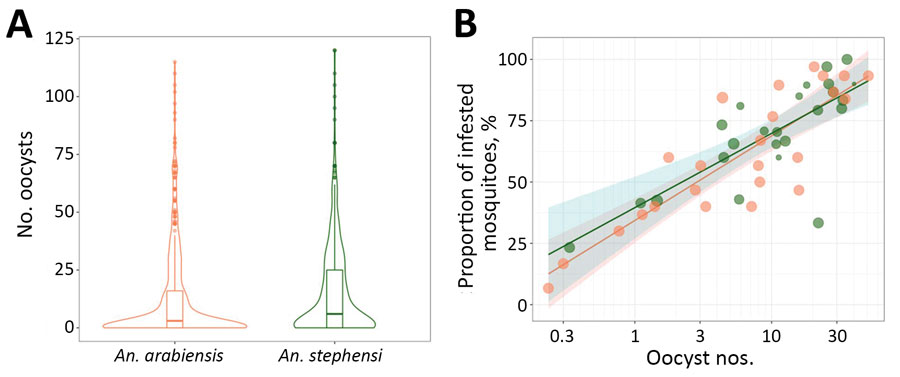Anopheles stephensi Mosquitoes as Vectors of Plasmodium vivax and falciparum, Horn of Africa, 2019
Fitsum G. Tadesse
1
, Temesgen Ashine
1, Hiwot Teka, Endashaw Esayas, Louisa A. Messenger, Wakweya Chali, Lisette Meerstein-Kessel, Thomas Walker, Sinknesh Wolde Behaksra, Kjerstin Lanke, Roel Heutink, Claire L. Jeffries, Daniel Abebe Mekonnen, Elifaged Hailemeskel, Surafel K. Tebeje, Temesgen Tafesse, Abrham Gashaw, Tizita Tsegaye, Tadele Emiru, Kigozi Simon, Eyuel Asemahegn Bogale, Gedeon Yohannes, Soriya Kedir, Girma Shumie, Senya Asfer Sabir, Peter Mumba, Dereje Dengela, Jan H. Kolaczinski, Anne Wilson, Thomas S. Churcher, Sheleme Chibsa, Matthew Murphy, Meshesha Balkew, Seth Irish, Chris Drakeley, Endalamaw Gadisa, and Teun Bousema
Author affiliations: Armauer Hansen Research Institute, Addis Ababa, Ethiopia (F.G. Tadesse, T. Ashine, H. Teka, E. Esayas, W. Chali, S.W. Behaksra, D.A. Mekonnen, E. Hailemeskel, S.K. Tebeje, T. Tafesse, A. Gashaw, T. Tsegaye, T. Emiru, E.A. Bogale, G. Shumie, S.A. Sabir, E. Gadisa); Radboud University Medical Center, Nijmegen, the Netherlands (F.G. Tadesse, L. Meerstein-Kessel, K. Lanke, R. Heutink, E. Hailemeskel, S.K. Tebeje, T. Bousema); Addis Ababa University, Addis Ababa (F.G. Tadesse, D.A. Mekonnen, E. Hailemeskel); United States Agency for International Development, Addis Ababa (H. Teka, S. Chibsa, M. Murphy); London School of Hygiene and Tropical Medicine, London, UK (L.A. Messenger, T. Walker, C.L. Jeffries, K. Simon, C. Drakeley, T. Bousema); President’s Malaria Initiative VectorLink Ethiopia Project, Addis Ababa (G. Yohannes, P. Mumba, M. Balkew); Oromia Regional Health Bureau, Adama, Ethiopia (S. Kedir); President’s Malaria Initiative VectorLink Project, Rockville, Maryland, USA (D. Dengela); World Health Organization, Geneva, Switzerland (J.H. Kolaczinski); Liverpool School of Tropical Medicine, Liverpool, UK; (A. Wilson); Imperial College London, London (T.S. Churcher); United States President’s Malaria Initiative, Atlanta, Georgia, USA (S. Chibsa, M. Murphy, S. Irish); Centers for Disease Control and Prevention, Atlanta (S. Irish)
Main Article
Figure 2

Figure 2. Comparison of relative oocyst numbers and infection rate for Anopheles stephensi and An. arabiensis mosquitoes in paired feeding experiments in study of An. stephensi mosquitoes as vectors of Plasmodium vivax and falciparum, Horn of Africa, 2019. Number of oocysts per infected midgut for individual mosquitoes of each of the 2 species. A) Violin plot showing estimated kernel density. Horizontal lines indicate median; box indicates interquartile range; and spikes indicate upper and lower adjacent values. The proportion of midguts with detectable oocysts (y-axis) is indicated in association with log10 transformed oocyst numbers (x-axis) for An. stephensi (green dots) and An. arabiensis (orange dots) mosquitoes. B) Data for 24 feeding experiments in which 723 An. arabiensis and 643 An. stephensi mosquitoes were dissected. Shaded area indicates 95% CI around estimates for An. stephensi (green) and An. arabiensis (orange) mosquitoes.
Main Article
Page created: January 08, 2021
Page updated: January 24, 2021
Page reviewed: January 24, 2021
The conclusions, findings, and opinions expressed by authors contributing to this journal do not necessarily reflect the official position of the U.S. Department of Health and Human Services, the Public Health Service, the Centers for Disease Control and Prevention, or the authors' affiliated institutions. Use of trade names is for identification only and does not imply endorsement by any of the groups named above.
